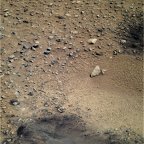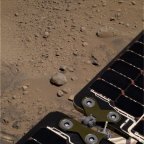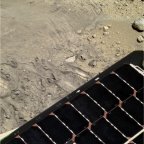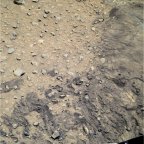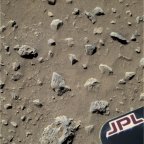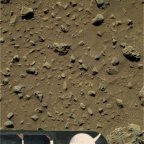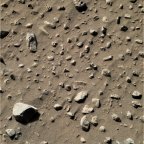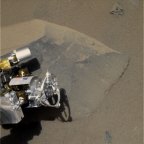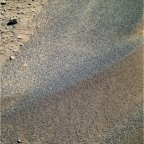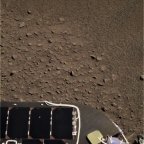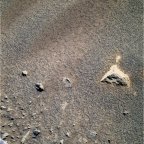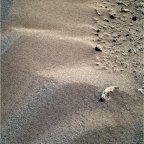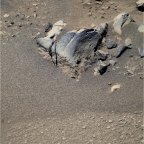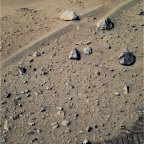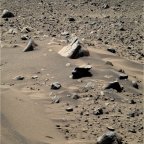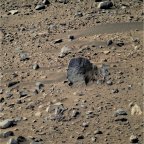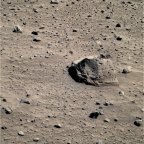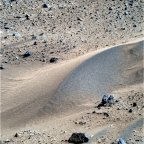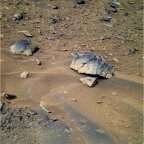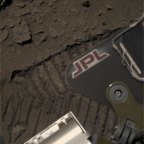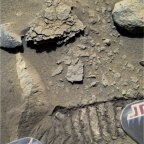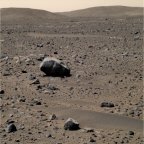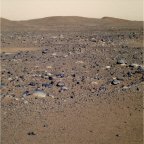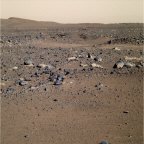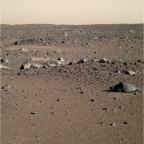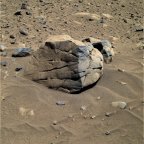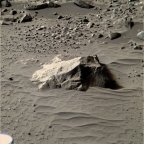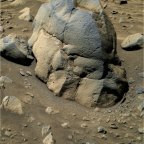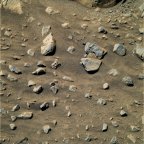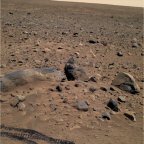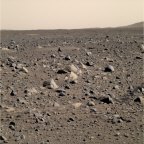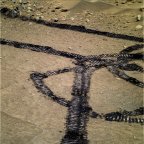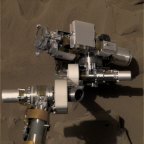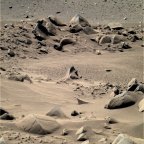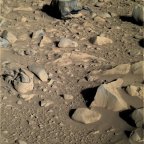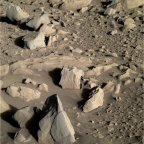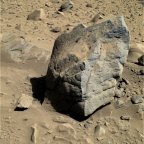Full Size Images from Spirit
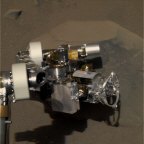
Spirit, Sol 30 11:42
This is the Spirit's arm that does brushing, grinding, and drilling. The rock is called Adirondack
2/2/2004
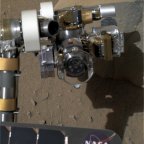
(Color filter 6 is missing.)
Spirit, Sol 34 10:35
This is the Spirit's arm that does brushing, grinding, and drilling. Blue band (L6) is missing. It's grinding into the rock called Adirondack.
2/6/2004
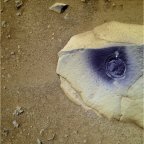
Spirit, Sol 35 11:27
The rock Adirondack, with the first hole ground into a rock on Mars.
The hole looks too blue, but I'm not sure why. The images show the blue to be there. Maybe it's an adjustment or filter?
2/7/2004
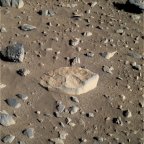
Spirit, Sol 36 15:32
White Boat is the first rock target that Spirit drove to after finishing a series of investigations on the rock Adirondack. White Boat stood out to scientists due to its light color and more tabular shape compared to the dark, rounded rocks that surround it.
2/9/2004
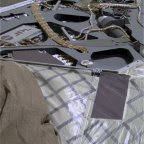
Description: (Color filter 3 is missing.)
Spirit, Sol 37 10:38
No red filter (3), I used filter 2 for a little red. The color isn't perfect, but it's a cool picture. Check out the man inside the 3 legos.

Spirit, Sol 53 14:14
"Humphrey" at Gusev Crater, Mars, the Mars Exploration Rover Spirit's landing site. Spirit examined the lumpy rock with its suite of scientific instruments both before and after it drilled a hole into the rock surface on the 60th martian day, or sol, of its mission. "Humphrey" was one of several stops on the rover's way to the large crater dubbed "Bonneville."
2/26/2004
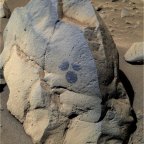
Spirit, Sol 55 13:12
"Humphrey" at Gusev Crater, Mars, the Mars Exploration Rover Spirit's landing site. Spirit examined the lumpy rock with its suite of scientific instruments both before and after it drilled a hole into the rock surface on the 60th martian day, or sol, of its mission. "Humphrey" was one of several stops on the rover's way to the large crater dubbed "Bonneville."
2/28/2004

Spirit, Sol 60 13:31
"Humphrey" at Gusev Crater, Mars, the Mars Exploration Rover Spirit's landing site. Spirit examined the lumpy rock with its suite of scientific instruments both before and after it drilled a hole into the rock surface on the 60th martian day, or sol, of its mission. "Humphrey" was one of several stops on the rover's way to the large crater dubbed "Bonneville."
3/4/2004
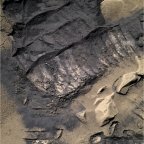
Spirit, Sol 72 11:58
The rover drove about two-and-a-half meters (8.2 feet) to put the left front wheel up onto the drift. It then turned right and left five degrees to dig the left front wheel into the drift. When the "shimmy" was complete, Spirit backed 10 centimeters (3.9 inches) out of the hole. The digging and backing process was repeated four times to thoroughly scuff Serpent's side. Then Spirit backed up another meter (3.28 feet) to attain miniature thermal emission spectrometer, panoramic camera and navigation camera observations of the scuffed area. These observations will aid in in-situ target selection. To prepare for the upcoming in-situ work, Spirit drove forward 0.4 meters (1.3 feet) for additional imaging, and then drove forward a final 0.45 meters (1.5 feet) to put the scuff in the arm work volume.
3/17/2004
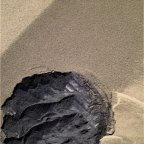
Spirit, Sol 72 12:08
The Mars Exploration Rover Spirit acquired this navigation camera image on the 72nd martian day, or sol, of its mission (March 15, 2004), after digging its wheel into the drift dubbed "Serpent." Creating the commands that would generate this "scar" was not an easy task for rover controllers. Essentially, they had to choreograph an intricate dance for Spirit, maneuvering it up the side of the dune, shimmying its left front wheel a number of times to create the scuff, and then reversing to attain proper positioning for miniature thermal emission spectrometer observations. Before the task was finished, Spirit moved forward to put the scuff within proper reach of the rover's arm.
This scar allows the rover's instruments to see below the drift surface, to determine the composition of the materials. Initial results indicate that the drift material is similar to the basaltic sands that have been seen throughout Spirit's journey to the large crater dubbed "Bonneville." The material does not seem to be the same as that inside the crater.
Scientists are now looking to answer two questions: Why is the dark sand in the crater not the same as the dark sand in the drift? And why are there two different dark soil-type deposits in such a small place?
3/17/2004
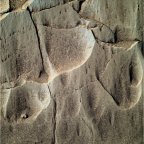
Spirit, Sol 78 10:34
NASA's Mars Exploration Rover Spirit took this panoramic camera image of the rock target named "Mazatzal" on sol 77 (March 22, 2004). It is a close-up look at the rock face and the targets that will be brushed and ground by the rock abrasion tool in upcoming sols.
Mazatzal, like most rocks on Earth and Mars, has layers of material near its surface that provide clues about the history of the rock. Scientists believe that the top layer of Mazatzal is actually a coating of dust and possibly even salts. Under this light coating may be a more solid portion of the rock that has been chemically altered by weathering. Past this layer is the unaltered rock, which may give scientists the best information about how Mazatzal was formed.
Because each layer reveals information about the formation and subsequent history of Mazatzal, it is important that scientists get a look at each of them. For this reason, they have developed a multi-part strategy to use the rock abrasion tool to systematically peel back Mazatzal's layers and analyze what's underneath with the rover's microscopic imager, and its Moessbauer and alpha particle X-ray spectrometers.
The strategy began on sol 77 when scientists used the microscopic imager to get a closer look at targets on Mazatzal named "New York," "Illinois" and "Arizona." These rock areas were targeted because they posed the best opportunity for successfully using the rock abrasion tool; Arizona also allowed for a close-up look at a range of tones. On sol 78, Spirit's rock abrasion tool will do a light brushing on the Illinois target to preserve some of the surface layers. Then, a brushing of the New York target should remove the top coating of any dust and salts and perhaps reveal the chemically altered rock underneath. Finally, on sol 79, the rock abrasion tool will be commanded to grind into the New York target, which will give scientists the best chance of observing Mazatzal's interior.
The Mazatzal targets were named after the home states of some of the rock abrasion tool and science team members.
3/23/2004
